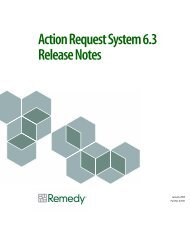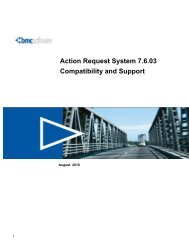BMC Remedy Action Request System 7.6.04: BMC Remedy Mid Tier ...
BMC Remedy Action Request System 7.6.04: BMC Remedy Mid Tier ...
BMC Remedy Action Request System 7.6.04: BMC Remedy Mid Tier ...
You also want an ePaper? Increase the reach of your titles
YUMPU automatically turns print PDFs into web optimized ePapers that Google loves.
<strong>BMC</strong> <strong>Remedy</strong> <strong>Action</strong> <strong>Request</strong> <strong>System</strong> <strong>7.6.04</strong><br />
90 <strong>BMC</strong> <strong>Remedy</strong> <strong>Mid</strong> <strong>Tier</strong> Guide<br />
A view is determined as follows:<br />
1 The system selects the view that the user has requested or by way of workflow. If<br />
no view is requested, or if the requested view does not exist, the default view is<br />
used.<br />
2 The system selects a view that is appropriate for the client that the user is running.<br />
If the client is on the Web, the system selects a view according to the Prefer<br />
Standard/Windows View option in the <strong>Mid</strong> <strong>Tier</strong> Configuration Tool.<br />
See Chapter 1, “Configuring the mid tier,” and the Form and Application Objects<br />
Guide, “How a form view is selected for the user,” page 394.<br />
3 The system selects a view that is appropriate for the user’s locale. If there is not an<br />
exact match, a fallback mechanism finds the closest possible locale to the one<br />
requested. The resulting view is then displayed for use.<br />
How locale is established<br />
URLs do not contain locale information. The system determines the correct locale<br />
in the following ways:<br />
If the user is not logged in, the system uses the browser's preferred locale list in<br />
prioritized order to try to match the closest locale. The World Wide Web<br />
Consortium (W3C) recommends this method for choosing a locale for a web<br />
page.<br />
If the user is logged in, the system uses the user’s preferences to set the locale. If<br />
no locale is set in the user preferences, then the system uses the browsersupplied<br />
list.<br />
Setting up searches for your end users<br />
Three types of searches are available for browsers:<br />
Saved searches—Searches that users can create and save for a form. Saved<br />
searches are saved to a system form called AR <strong>System</strong> Searches Preference. Each<br />
search is an entry in this form. Users must have this form installed in their<br />
preference server to save searches on the web. If you do not have this form<br />
installed, import it by using <strong>BMC</strong> <strong>Remedy</strong> Developer Studio.<br />
Recent searches—A list of searches that a user has executed recently. When a<br />
user executes a new search, it is added to the list of recent searches. The number<br />
of recent searches is configured in the AR <strong>System</strong> User Preference form. If the<br />
maximum number of recent searches has been reached, the oldest of the recent<br />
searches is replaced by the newest search. These searches are also saved in the<br />
AR <strong>System</strong> Searches Preference form.<br />
Defined searches—Searches defined by the administrator. Each defined search<br />
is associated with a specific form view, and is stored as part of the properties for<br />
that view.





